
Chair Lift for Stairs
Recommendations, How to and Buying Guide
Some elderly have difficulty climbing and descending stairs. With a chair lift for stairs, they can have access to their entire home again.
They no longer have to change or limit their daily routine because they cannot go up and down the stairs safely.
A chair lift for stairs will allow your elderly parents to be independent and self sufficient - which for most seniors is essential for their quality of life.
They are a great alternative to moving to another home or renovating to install a residential elevator.
When elderly develop a mobility problem and their home has stairs that they need to use everyday, then they need to look at acquiring a chair lift for stairs.
Stair lifts are easily installed into any stairway where the condition of the stair tread is good - as the railing that the stair lift uses is attached to the stair tread.
Read more below to determine if a stair lift would help your elderly parents.
Who Should Use?
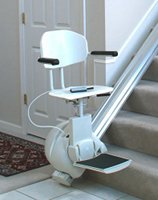
Stairs present a mobility challenge and a potential danger for the elderly who are struggling with mobility issues (such as being unsteady on their feet).
Falling down stairs is a leading cause of serious injury among the elderly and installing a chair lift for stairs can reduce the risk of falls.
A chair lift will not only be a safer method for movement up and down stairs by those with mobility issues but they will also provide an important sense of independence and freedom.
Features to Consider When Purchasing
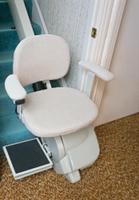
There are a number of features to consider when purchasing a chair lift for stairs:
- Exterior package - Allows stair chair lifts to be used outdoors. Can be a challenge to operate if snow or heavy rain is a factor.
- Keyed stair chairs - Cannot be operated unless key is in place and turned to on position.
- Flip up rail - Permits bottom section of rail to be flipped up out of way. Manual and power available for some models.
- Hand held pendant control - Allows a caregiver to control the operation of the stair lift.
- Track lengths - For stairways in excess of 16' - lengths up to 45 ft are possible depending on model.
- Standing lift - Allows senior to stand instead of sit. This is beneficial for narrow stairways or for elderly who cannot bend their legs to place their feet on the footrest.
- Weight capacity - They are some chair lift for stairs for seniors who are over 300 lbs. Confirm model also has increased seat width.
- Seat depth of 18" - If the senior is tall (over 6 feet) or is using a wheelchair and requires more seat stability, then a deeper seat should be considered.
Advantages and Disadvantages
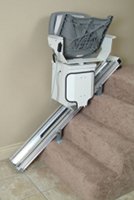
There are a number of advantages and disadvantages of chair lift for stairs:
Advantages
1. Independence
- Stair chairs are mechanical chair lifts that allow the elderly to move easily between different floors of a house. One of the biggest advantages of stair chairs has to be the independence it can give seniors.
- If a senior has mobility challenges and is unable to leave their own home without assistance from others, they are likely to feel trapped and helpless.
- The emotional relief and the sense of freedom stair chairs can provide these seniors is priceless.
2. Reduce Stress on Caregiver
- Caregivers also benefit from having stair chairs in a home. Moving a senior up/down stairs without such a device is potentially dangerous.
3. Stay in their Home
- Another advantage of chair lifts for stairs is that they can allow a senior with a mobility issue to remain in a home that they love.
- Often seniors are forced to move because of their mobility issues that prevent them from living in houses with stairs, but a stair chair eliminates this need altogether.
Disadvantages
1. Cost
- The biggest disadvantage of installing a stair chair in a house is the cost. A chair lift for stairs can be expensive to purchase, although recently prices are declining due to competition between manufacturers.
- Leasing or renting a stair chair is also an option for those who cannot afford to purchase one.
- In the end, installing a stair lift can actually save money as it can prevent or delay moving to a senior housing community (which is often more expensive than living in an existing home).
2. Damage to Stairs
- Another disadvantage may be the damage done to certain staircases when the stair chair is installed.
- For those with beautifully crafted wood stairways, it may be hard to see the railings removed or modified so that the stair chair can be installed.
- However, this is likely outweighed by the independence/freedom provided by chair lifts for stairs.
Things to Consider When Purchasing
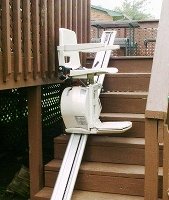
There are many things to consider when purchasing stair lift chairs, including:
- Weight and height of senior(s) - If the stairs are not very wide (less than 37") then a taller senior may have difficulty with their knees reaching the other side of the stairs. The option of a standing or perching model may be better in this case than a chair lift for stairs.
- Transfer ability - The senior needs to able to safely be able to get on and off a chair to use a stair lift. If they will have difficulty, then they should consider another type of lift such as a wheelchair stair lift.
- Curved or straight stairway - If curved, what is the shape of the curve and is there another set of stairs as chair lifts for curved stairways are more expensive.
- Side of stairs - Will the lift be on the right or left looking up from bottom?
- Width - Width of stairs in inches? Is the width of stairs constant?
- Hand rails - Is there an existing hand rail?
- Total length - The rail for the chair lift must go right to the top and bottom of the stairs to ensure easy mounting and dismounting.
- Available power - The ability to use battery and power. Battery power is useful when there is a power outage so seniors will not be stuck upstairs, downstairs or in-between
- Seat and footplate fold up - The chair stair lift has a folding footplate and guard rails, which is very useful when the stairway is narrow. It allows visitors to more easily walk past the lift when using the stairs normally.
- Swivel seat - Swivel seats are more convenient and safer as they allow for easier mounting and dismounting.
- Safety sensors - Modern stair lifts have safety sensors. If an object is in the way of the chair lift when moving up and down it will stop until the obstruction is removed.
- Easy to use controls - Make sure the controls are easy to use. There is push button, paddle and infrared controls. The infrared controls mean you can call for the lift to be sent to where-ever you are. The paddle switch is located on the end of the seat arm, of the chair lift and of course the remote can be wherever you want to keep it.
- Braking system - Braking systems are a very important consideration as a part of safety. There are dual electronic and mechanical ones. This means that the chair lift is unable to descend unexpectedly or at speed. A lockable isolation switch ensures that the chair lift always stops in the correct position.
- Condition of stair treads - Because the rail mounts to stair treads, not to wall, the stairs must be in good condition.
- Narrow stairs - If the stairs are narrow (less than 37") than the track distance from the wall will be a key issue. This factor is also dependent on the height of the stair lift user and their leg length.
- Seat height - If the senior has difficulty transferring to the seat of the chair then seat height will be a key issue.
- Soft start - Feature that ensures a smooth start as opposed to a quick jarring start. If the senior has chronic pain than a soft start and stop is a good idea.
- Seat depth - If the senior is tall then seat depth of the chair lift is important.
- Lighting - For safety, the stairway must have adequate lighting at top and bottom of stairs.
- Top of stairs/end of track - Track must be allowed to come all the way to the top landing and bottom landing for safe transfer to the seat of electric stair chair lifts.
Can They Be Installed on Curved Stairways?
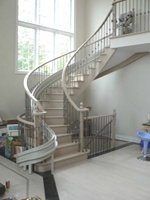
When shopping for a chair lift, stairway design will be a major determining factor in how much you will have to pay to have your chair lift installed in your home.
The main purpose of a chair lift is, of course, to move a senior between different levels of a home. However, not all houses have the same stairway designs.
A beautifully curved staircase may have been a plus when originally purchasing a home, but when you are pricing chair lifts for stairs they may make a chair lift very expensive.
In general chair lift for stairs are best if they are for straight rail staircases. These are the easiest models for most chair lift manufacturers to accommodate and they will be the cheapest chair lift for stairs models you can purchase.
However, you can purchase a chair lift for winding stairs. Curved rail staircases will require individual fitting and meticulous measurements, and will incur additional pricing and material costs. Still, the freedom of mobility will likely be well worth the price.
Another major disadvantage of curved rail staircases is that it will more difficult to find cheaper chair lift options. Most rentals or refurbished chair lifts for stairs will be designed for straight rail staircases.
If you have a curved rail stairway and are committed to having a chair lift installed on these stairs, you should certainly price comparison shop with different manufacturers.
Standing/Perching Stair Lifts
Standing and perching stair lifts are designed for narrow stairways where a regular chair lift would not fit due to the narrow width.
They are only suitable for elderly who have the ability to stand for several minutes - the length of time it takes to move up or down the stairs.
There is a rail that they can hold onto for security. If they cannot tolerate standing for even short periods of time, a seated chair lift for stairs is the best option.
The difference between the standing and perching stair lift is the perching model has support beneath the buttocks to help take the weight off the senior's legs. Both models share the same features as seated chairlifts in that the footplate folds up and so do the rails.
How to Install?
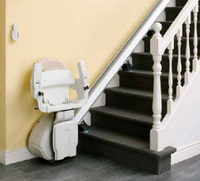
Your home's structure should not hinder the installation of a chair lift for stairs because the lift is installed on the stair treads.
- Let the professionals do the installation - Installation of a chair lift for stairs is usually more than the average family would want to handle themselves. They are many reasons why stair chairs are something you may want a local dealer to install.
- Need to be familiar with lift switches - When a lift is installed the trip switches tend to be the most problematic part.
- Expensive to damage - Trip switches are easy to damage during installation regardless of the manufacturer or model
- Many details to problem solve - The footplate hitting the stairs and activating a stop switch can be common if the lift is not installed properly.
- Drive system - Most manufacturers boast that their drive system is better than others. In actual fact, most stair chair systems are comparable in durability. Rack and pinion, cable and chain are common. Rack and pinion manufacturers are critical about other stair chair lift drive systems yet most elevators run on cable or chain systems.
- Track alignment - Tracks require proper alignment to ensure the stairway lift does not stop when no one technical is close by.
- Regular maintenance - It is common for most stair chair models to be serviced each year to avoid break downs.
- Local service support - If a family member is not local or available within an hours notice then a local installer is extremely important.
How to Maintain?
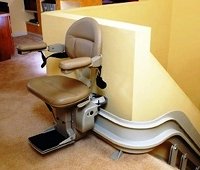
Regular maintenance is important in ensuring the stair lift works safely and for a long time.
- Service every six months or as per the manufacturers instructions.
- Most manufacturers will void the warranty if units are not serviced by an approved dealer.
- Service usually requires the unit to be dismantled to some extent - requiring both time and expertise.
- When a home lift does not work it usually requires some wiring expertise to problem solve.
How Much Do They Cost?
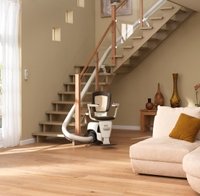
There is a lot of variation among manufacturers in terms of the actual stairway lift prices.
Prices will depend on what kind of chair lift for stairs you are interested in purchasing and what type of stairways you have (straight, curved, length).
Other factors that can affect price include whether you are buying a new or refurbished model, installation costs, and whether you will be receiving some kind of government assistance or rebate.
Prices for a simple stair lift for straight stairs often range between $3000 to $4000, but for more elaborate stairways and chairs, the price can be as much as $15,000 (or even more, in some cases). For this reason, you should carefully compare manufacturers, prices and features.
Many companies selling chair lifts for stairs are reluctant to give a price quote over the phone or internet.
If you are looking to reduce your chair lift costs, you may want to consider purchasing a used or refurbished model. However, you will want to make sure there is some kind of warranty to make repairs if needed soon after installation (preferably a twelve month warranty).
Renting a chair stair lift is another option offered by some dealers.
If you are in real need of a chair lift for stairs but do not have the cash at hand to make the purchase, some companies will also have financing available.


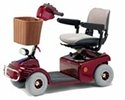



New! Comments
Have your say about what you just read! Leave me a comment in the box below.